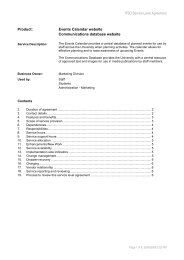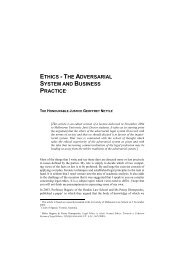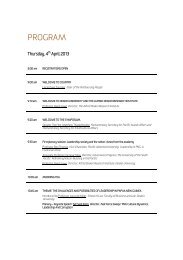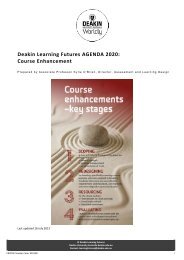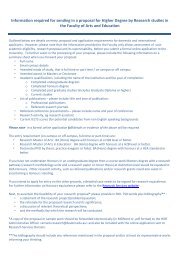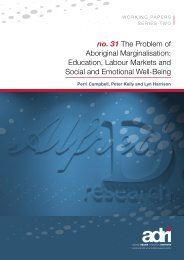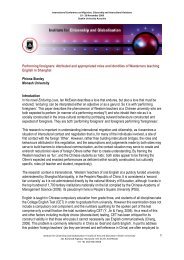baker v the queen fardon v attorney general for ... - Deakin University
baker v the queen fardon v attorney general for ... - Deakin University
baker v the queen fardon v attorney general for ... - Deakin University
You also want an ePaper? Increase the reach of your titles
YUMPU automatically turns print PDFs into web optimized ePapers that Google loves.
BAKER V THE QUEEN<br />
&<br />
FARDON V ATTORNEY GENERAL<br />
FOR THE STATE OF<br />
QUEENSLAND<br />
OSCAR ROOS*<br />
[In 2004, <strong>the</strong> High Court of Australia had cause to revisit its 1996 decision<br />
in Kable, as well as to consider <strong>the</strong> nature of judicial power as it relates to<br />
<strong>the</strong> deprivation of liberty, outside of <strong>the</strong> parameters of conventional criminal<br />
sentencing. The resulting decisions of Fardon and Baker demonstrate <strong>the</strong><br />
lack of constitutional protections af<strong>for</strong>ded to people who become <strong>the</strong> focus of<br />
governmental campaigns to be “tough on crime”. The so-called “Kable<br />
principle”, as construed by <strong>the</strong> High Court in 2004, may prove to be <strong>the</strong><br />
“constitutional watch dog that barks but once”.]<br />
I<br />
INTRODUCTION<br />
On 1 October 2004 <strong>the</strong> High Court of Australia handed down two cases with significant<br />
implications <strong>for</strong> civil liberties. In Baker v The Queen 1 <strong>the</strong> Court was called<br />
upon to decide <strong>the</strong> constitutionality of provisions of a NSW Act 2 which severely<br />
restricted <strong>the</strong> rights of certain prisoners who had been sentenced to life imprisonment<br />
to obtain a determination of <strong>the</strong>ir sentence by way of a fixed minimum term.<br />
In Fardon v Attorney General <strong>for</strong> <strong>the</strong> State of Queensland 3 a Queensland prisoner,<br />
whose release on <strong>the</strong> expiration of his sentence was denied on <strong>the</strong> basis that he was<br />
an ‘unacceptable risk’ of committing a ‘serious sexual offence’, asked <strong>the</strong> Court to<br />
declare provisions of a Queensland Act 4 which authorised his continued detention<br />
*<br />
Associate Lecturer, School of Law, <strong>Deakin</strong> <strong>University</strong> and member of <strong>the</strong> Victorian Bar.<br />
1 Baker v. The Queen, (2004) 210 ALR 1 (High Court of Australia, 2004)<br />
2 Sentencing Act, 1989, (NSW.) as amended by Sentencing Legislation Fur<strong>the</strong>r Amendment Act, 1997,<br />
(NSW.)<br />
3 Fardon v. Attorney General <strong>for</strong> <strong>the</strong> State of Queensland, (2004) 210 ALR 50 (High Court of Australia,<br />
2004)<br />
4 Dangerous Prisoners (Sexual Offenders) Act, 2003, (Qld.)
272 DEAKIN LAW REVIEW VOLUME 10 NO 1<br />
unconstitutional. In both cases, a six to one majority of <strong>the</strong> Court (Kirby J dissenting)<br />
decided in favour of <strong>the</strong> validity of <strong>the</strong> relevant State legislation.<br />
II<br />
FACTS<br />
A<br />
Baker v The Queen<br />
The appellant, Allan Baker, was a New South Wales prisoner who had been sentenced<br />
in 1974 along with his co offender 5 to a sentence of life imprisonment on<br />
one count of murder and one count of conspiracy to murder. At <strong>the</strong> time of <strong>the</strong><br />
imposition of his sentence, life imprisonment was mandatory on a conviction <strong>for</strong><br />
murder, with no provision <strong>for</strong> minimum or non parole terms. 6 There was, however,<br />
provision <strong>for</strong> executive discretion to allow <strong>for</strong> <strong>the</strong> supervised release of prisoners,<br />
including prisoners subject to such mandatory life sentences. 7 In sentencing Mr<br />
Baker and his co offender, <strong>the</strong> trial judge, Taylor J, remarked, “I believe that you<br />
should spend <strong>the</strong> rest of your lives in gaol and <strong>the</strong>re you should die. If ever <strong>the</strong>re<br />
was a case where life imprisonment should mean what it says – <strong>the</strong> imprisonment<br />
<strong>for</strong> <strong>the</strong> whole of your lives – this is it”. 8<br />
This remark, which had “no normative legal operation” 9 at <strong>the</strong> time it was uttered in<br />
1974, was to come back to haunt Mr Baker almost 30 years later when he applied<br />
<strong>for</strong> a determination of <strong>the</strong> sentence passed on him in 1974.<br />
The practice of exercising executive discretion to permit <strong>the</strong> supervised release of<br />
prisoners prior to <strong>the</strong> expiration of <strong>the</strong>ir sentence, known vernacularly as “tickets of<br />
leave”, 10 was heavily criticised during <strong>the</strong> “truth in sentencing” 11 debate and was<br />
abolished in NSW in 1989. 12 It was replaced with a system of minimum terms and<br />
parole orders. Prisoners who had been sentenced prior to <strong>the</strong> 1989 re<strong>for</strong>ms could<br />
apply to <strong>the</strong> NSW Supreme Court <strong>for</strong> <strong>the</strong> determination of <strong>the</strong>ir sentence by way of<br />
a declaration of a minimum non parole term and additional term <strong>for</strong> sentence. 13 Mr<br />
Baker’s co offender did so successfully apply <strong>for</strong> a determination of his life sen-<br />
5 Kevin Garry Crump: see below n 14.<br />
6<br />
Crimes Act, 1900, s 19 (NSW) (section now repealed by Crimes (Life Sentences) Amendment Act,<br />
1989, (NSW)<br />
7<br />
Crimes Act, 1900, s 463 (NSW) (section now repealed by Prisons (Serious Offenders Review Board)<br />
Amendment Act, 1989 (NSW)<br />
8 Baker v. The Queen, (2004) 210 ALR 1, 10 [26] (High Court of Australia, 2004)<br />
9 Baker v. The Queen, (2004) 210 ALR 1, 31 [113] (High Court of Australia, 2004) (Kirby J); see also<br />
Baker v. The Queen, (2004) 210 ALR 1, 32 [114] (High Court of Australia, 2004): “<strong>the</strong> administrative<br />
authorities might take a sentencing judge’s ‘recommendation’ into account in per<strong>for</strong>ming <strong>the</strong>ir functions.<br />
They might not”.<br />
10 Baker v. The Queen, (2004) 210 ALR 1, 10 [27] (High Court of Australia, 2004)<br />
11 Baker v. The Queen, (2004) 210 ALR 1, 6 [10] (High Court of Australia, 2004)<br />
12 By <strong>the</strong> Prisons (Serious Offenders Review Board) Amendment Act, 1989, s 5 (NSW.)<br />
13<br />
Sentencing Act, 1989, s 13A(2) (NSW.) (now amended by Sentencing Legislation Fur<strong>the</strong>r Amendment<br />
Act 1997 (NSW.))
2005 Baker and Fardon 273<br />
tence. 14 In response, <strong>the</strong> NSW Parliament sought to restrict <strong>the</strong> ability of prisoners<br />
serving indefinite life sentences to avail <strong>the</strong>mselves of <strong>the</strong> 1989 re<strong>for</strong>ms and passed<br />
<strong>the</strong> Sentencing Legislation Fur<strong>the</strong>r Amendment Act 1997 (NSW) (“<strong>the</strong> 1997 NSW<br />
Act”). It was <strong>the</strong> amendments made by <strong>the</strong> 1997 NSW Act to <strong>the</strong> Sentencing Act<br />
1989 (NSW) which were <strong>the</strong> subject of constitutional challenge by Mr Baker.<br />
Under <strong>the</strong> amendments introduced by <strong>the</strong> 1997 NSW Act, “a person who is <strong>the</strong><br />
subject of a non release recommendation” could not apply <strong>for</strong> a minimum term and<br />
additional term until, inter alia, <strong>the</strong>y could satisfy <strong>the</strong> Supreme Court of NSW that<br />
“special reasons exist that justify making <strong>the</strong> determination”. 15<br />
The 1997 NSW Act came into <strong>for</strong>ce on 9 May 1997. On 1 August 1997 Mr Baker<br />
applied to <strong>the</strong> Supreme Court of New South Wales <strong>for</strong> an order determining <strong>the</strong><br />
minimum and additional terms of his life sentence. It was common ground between<br />
<strong>the</strong> parties that <strong>the</strong> remarks of Taylor J on sentencing Mr Baker in 1974 constituted<br />
a “non release recommendation” <strong>for</strong> <strong>the</strong> purposes of <strong>the</strong> 1997 NSW Act. 16 There<strong>for</strong>e,<br />
Mr Baker had to demonstrate that “special reasons existed” be<strong>for</strong>e he could<br />
apply <strong>for</strong> a minimum term, effectively his only hope <strong>for</strong> eventual release.<br />
Despite <strong>the</strong> unchallenged evidence that since his incarceration at age 25 17 Mr Baker<br />
had developed into an “exemplary’ prisoner” 18 who presented as a “very good”<br />
prospect <strong>for</strong> rehabilitation, 19 both <strong>the</strong> judge at first instance, 20 and <strong>the</strong> Court of<br />
Criminal Appeal, 21 determined that he had not made out <strong>the</strong> existence of “special<br />
reasons” and was <strong>the</strong>re<strong>for</strong>e ineligible <strong>for</strong> a determination of his life sentence.<br />
B<br />
Fardon v Attorney General <strong>for</strong> <strong>the</strong> State of Queensland<br />
In 2003 <strong>the</strong> Queensland Parliament passed <strong>the</strong> Dangerous Prisoners (Sexual Offenders)<br />
Act 2003 (Qld) (“<strong>the</strong> Queensland Act”). It conferred upon <strong>the</strong> Queensland<br />
Supreme Court <strong>the</strong> power to “provide <strong>for</strong> <strong>the</strong> continued detention in custody or<br />
supervised release of a particular class of prisoner to ensure adequate protection of<br />
<strong>the</strong> community” 22 and provided <strong>for</strong> <strong>the</strong> Attorney General to apply to <strong>the</strong> Queensland<br />
Supreme Court <strong>for</strong> <strong>the</strong> continued detention of prisoners who were nearing <strong>the</strong> end<br />
14<br />
Application of Kevin Garry Crump (Unreported, Supreme Court of NSW, McInerney J, 24 April<br />
1997).<br />
15 Sentencing Act, 1989, s 13A(3A) (NSW.) as amended by Sentencing Legislation Fur<strong>the</strong>r Amendment<br />
Act, 1997, Sch 1, item 2 (NSW.)<br />
16 Baker v. The Queen, (2004) 210 ALR 1, 10 [26] (High Court of Australia, 2004)<br />
17<br />
Mr. Baker was arrested on 13 November 1973 aged 25 and has remained in custody since his arrest:<br />
Baker v. The Queen, (2004) 210 ALR 1, 10 [25] (Gleeson CJ) (High Court of Australia, 2004)<br />
18 R v. Baker, [2001] NSWSC 412 [109] (G R James J) ( Supreme Court of New South Wales, 2001)<br />
19 R v. Baker, [2001] NSWSC 412 [122] ( Supreme Court of New South Wales, 2001)<br />
20 R v. Baker, [2001] NSWSC 412 (G R James J) ( Supreme Court of New South Wales, 2001)<br />
21 R v. Baker, (2002) 130 A Crim R 417 (New South Wales Court of Criminal Appeal, 2002)<br />
22 Dangerous Prisoners (Sexual Offenders) Act, 2003, s 3, 8 (Qld.)
274 DEAKIN LAW REVIEW VOLUME 10 NO 1<br />
of <strong>the</strong>ir original sentence of imprisonment. 23 To fall under <strong>the</strong> purview of <strong>the</strong><br />
Queensland Act <strong>the</strong> prisoner had to be serving a sentence with respect to a “serious<br />
sexual offence”, 24 defined in <strong>the</strong> Schedule to <strong>the</strong> Queensland Act as an “offence of a<br />
sexual nature involving violence or against children”.<br />
One such prisoner was Robert John Fardon. Mr Fardon had been convicted on 30<br />
June 1989 of offences of rape, sodomy and assault occasioning actual bodily harm<br />
<strong>for</strong> which he was sentenced to 14 years jail. Mr Fardon was due to be released on<br />
or about 30 June 2003. The Queensland Act came into <strong>for</strong>ce on 6 June 2003.<br />
Prior to Mr Fardon’s scheduled release, under <strong>the</strong> terms of <strong>the</strong> Queensland Act, <strong>the</strong><br />
Attorney General initially applied <strong>for</strong> an interim detention order 25 which was<br />
granted on 27 June 2003. The Attorney General ultimately applied <strong>for</strong> a final<br />
‘indefinite detention’ order which was granted on 6 November 2003. 26 Mr Fardon<br />
was <strong>the</strong>re<strong>for</strong>e never released, even though he had served out his sentence.<br />
III THE KABLE PRINCIPLE & ITS APPLICATION IN<br />
FARDON AND BAKER<br />
Both Mr Baker and Mr Fardon sought to invoke <strong>the</strong> ‘Kable principle’ to invalidate<br />
<strong>the</strong> relevant provisions of <strong>the</strong> NSW Act and <strong>the</strong> Queensland Act respectively.<br />
The High Court’s 1996 decision in Kable v DPP (NSW) 27 determined that where a<br />
state legislature sought to confer powers upon a state court which was vested with<br />
Commonwealth jurisdiction pursuant to Chapter III of <strong>the</strong> Constitution, that state<br />
legislature could not confer those powers if <strong>the</strong>y would have <strong>the</strong> effect of compromising<br />
<strong>the</strong> integrity of <strong>the</strong> judicial system brought into existence by Chapter III of<br />
<strong>the</strong> Constitution by being “repugnant to or incompatible with” 28 <strong>the</strong> exercise of<br />
federal judicial power. As put by one of <strong>the</strong> justices in <strong>the</strong> majority in Kable:<br />
While nothing in Chapter III prevents a State from conferring non-judicial<br />
functions on a State Supreme Court in respect of non-federal matters, those<br />
non-judicial functions cannot be of a nature that might lead an ordinary<br />
reasonable member of <strong>the</strong> public to conclude that <strong>the</strong> Court was not independent<br />
of <strong>the</strong> executive government of <strong>the</strong> State. 29<br />
23<br />
Dangerous Prisoners (Sexual Offenders) Act, 2003, s 8 (Qld.) (re an ‘interim detention order’) and<br />
Dangerous Prisoners (Sexual Offenders) Act, 2003, s 13 (Qld.) (re a ‘continuing detention order’)<br />
24 Dangerous Prisoners (Sexual Offenders) Act, 2003, s 5(6) (Qld.)<br />
25 Dangerous Prisoners (Sexual Offenders) Act, 2003, s 8 (Qld.)<br />
26 Attorney General <strong>for</strong> <strong>the</strong> State of Queensland v. Fardon, [2003] QSC 379 (Supreme Court of Queensland,<br />
2003)<br />
27 Kable v. DPP (NSW), (1996) 189 CLR 51 (High Court of Australia, 1996)<br />
28 Kable v. DPP (NSW), (1996) 189 CLR 51, 103 (Gaudron J) (High Court of Australia, 1996); see also<br />
John Fairfax Publications Pty Ltd v. Attorney General (NSW.), (2000) 158 FLR 81, 88 (Spegelman J)<br />
29 Kable v. DPP (NSW), (1996) 189 CLR 51, 117 (McHugh J) (High Court of Australia, 1996)
2005 Baker and Fardon 275<br />
The principle propounded in Kable represented a significant departure from <strong>the</strong><br />
Court’s previous approach that “<strong>the</strong> Commonwealth must take State Courts as it<br />
finds <strong>the</strong>m”. 30 In its immediate aftermath, Kable was identified by some commentators<br />
as a portal through which certain civil libertarian rights, <strong>for</strong> example a protection<br />
against retrospective punishment, could be protected under our present<br />
Constitution. 31 In <strong>the</strong> more sombre light cast by Fardon and Baker, it appears now<br />
that those hopes were misplaced. As put by Kirby J in his dissenting judgement in<br />
Baker, Kable has so far proven to be <strong>the</strong> constitutional guard-dog that has barked<br />
but once. 32<br />
A<br />
Baker & <strong>the</strong> Kable Principle<br />
Mr Baker sought to invoke <strong>the</strong> Kable principle by arguing that <strong>the</strong> requirement of<br />
“special reasons” imposed on him by <strong>the</strong> 1997 NSW Act as a precondition <strong>for</strong><br />
eligibility to apply <strong>for</strong> a determination of his life sentence was so “devoid of content<br />
and illusory” 33 that it was not a proper condition <strong>for</strong> <strong>the</strong> exercise of judicial power.<br />
His argument was roundly rejected by all <strong>the</strong> justices of <strong>the</strong> Court save Kirby J. In<br />
<strong>the</strong>ir joint majority judgement, McHugh, Gummow, Hayne and Heydon JJ refer to<br />
numerous examples where judicial power is validly exercised by reference to “imprecisely<br />
expressed criteria”, akin to <strong>the</strong> qualification of “special reasons” found in<br />
<strong>the</strong> 1997 NSW Act. 34 In conclusion, McHugh, Gummow, Hayne and Heydon JJ<br />
expressly state that:<br />
[i]f <strong>the</strong> provisions of <strong>the</strong> [1997 NSW Act] under challenge had been laws<br />
of <strong>the</strong> Commonwealth, <strong>the</strong>y would have complied with <strong>the</strong> principles<br />
found in Chapter III of <strong>the</strong> Constitution <strong>for</strong> <strong>the</strong> exercise of federal jurisdiction<br />
by federal courts and by state courts invested pursuant to a law made<br />
under s 77(iii) of <strong>the</strong> Constitution. 35<br />
Thus, Mr Baker failed <strong>the</strong> first hurdle of Kable invalidity as propounded in <strong>the</strong> 1998<br />
decision of <strong>the</strong> Court in H A Bachrach Pty Ltd v Queensland 36 : “[I]f <strong>the</strong> law in<br />
question …had been a law of <strong>the</strong> Commonwealth and it would not offend have<br />
offended [<strong>the</strong> principle propounded in Kable], <strong>the</strong>n an occasion <strong>for</strong> <strong>the</strong> application<br />
of Kable does not arise”. 37<br />
30<br />
Fardon v. Attorney General <strong>for</strong> <strong>the</strong> State of Queensland, (2004) 210 ALR 50, 63 [38] (McHugh J)<br />
(High Court of Australia, 2004)<br />
31 See, e.g. Mirko Bagaric & Tanya Lakic, Victorian Sentencing Turns Retrospective: The Constitutional<br />
Validity of Retrospective Criminal Legislation after Kable, 23 CRIMINAL L. J. 145, 154-8 (1999); James<br />
Miller, Criminal Cases in <strong>the</strong> High Court of Australia, 21 CRIMINAL L. J. 92, 99-103 (1997)<br />
32 Baker v. The Queen, (2004) 210 ALR 1,17 [54] (High Court of Australia, 2004)<br />
33 Baker v. The Queen, (2004) 210 ALR 1, 6 [11] (Gleeson CJ) (High Court of Australia, 2004)<br />
34<br />
Baker v. The Queen, (2004) 210 ALR 1,14 [42] (High Court of Australia, 2004); see also, Baker v.<br />
The Queen, (2004) 210 ALR 1, 7 [13] (Gleeson CJ) (High Court of Australia, 2004)<br />
35 Baker v. The Queen, (2004) 210 ALR 1, 9-10 [24] (High Court of Australia, 2004)<br />
36 H A Bachrach Pty Ltd v. Queensland, (1998) 195 CLR 547 (High Court of Australia, 1998)<br />
37 H A Bachrach Pty Ltd v. Queensland, (1998) 195 CLR 547, 562 (High Court of Australia, 1998).
276 DEAKIN LAW REVIEW VOLUME 10 NO 1<br />
The o<strong>the</strong>r two majority justices, Gleeson CJ and Callinan J, whilst adopting similar<br />
reasoning to <strong>the</strong> joint majority judgement, reduce Mr Baker’s argument to a necessary<br />
assertion that <strong>the</strong> determination of special reasons under <strong>the</strong> 1997 NSW Act<br />
must be impossible to fulfil and <strong>the</strong>re<strong>for</strong>e a “charade” 38 or “a futility” 39 <strong>for</strong> <strong>the</strong> 1997<br />
NSW Act to attract <strong>the</strong> possible operation of <strong>the</strong> Kable principle. They conclude<br />
that “[t]here is real content” 40 in <strong>the</strong> criteria of “special reasons” contained in <strong>the</strong><br />
1997 NSW Act.<br />
B<br />
Fardon & <strong>the</strong> Kable principle<br />
The majority justices, Callinan and Heydon JJ in a joint judgement and Gleeson CJ,<br />
Gummow and McHugh JJ in separate judgements, all find that <strong>the</strong>re are substantial<br />
differences between <strong>the</strong> provisions of <strong>the</strong> Queensland Act and <strong>the</strong> legislation which<br />
was invalidated in Kable. In traversing <strong>the</strong> scheme established by <strong>the</strong> Queensland<br />
Act, <strong>the</strong>y place particular emphasis on its provisions <strong>for</strong> <strong>the</strong> application of <strong>the</strong> laws<br />
of evidence and an adversarial system, with an onus upon <strong>the</strong> Attorney General to<br />
establish “by acceptable, cogent evidence to a high degree of probability” 41 that <strong>the</strong><br />
prisoner is a “serious danger to <strong>the</strong> community”. 42 The virtue of <strong>the</strong>se provisions<br />
contrasts with <strong>the</strong> vice of <strong>the</strong> legislation invalidated in Kable. Thus:<br />
[n]othing in <strong>the</strong> [Queensland] Act gives any ground <strong>for</strong> concluding that it<br />
impairs <strong>the</strong> institutional capacity of <strong>the</strong> Supreme Court to exercise federal<br />
jurisdiction….[n]othing in <strong>the</strong> [Queensland] Act might lead a reasonable<br />
person to conclude that <strong>the</strong> Supreme Court of Queensland, when exercising<br />
federal jurisdiction, might not be an impartial tribunal free of governmental<br />
or legislative influence or might not be capable of administering<br />
invested federal jurisdiction according to law. 43<br />
Of all <strong>the</strong> majority judgements, <strong>the</strong> joint judgement of Callinan and Heydon JJ<br />
provides <strong>the</strong> most sweeping endorsement of <strong>the</strong> contested provisions of <strong>the</strong> Queensland<br />
Act. Their Honours characterise <strong>the</strong> Queensland Act as “protective” of <strong>the</strong><br />
community ra<strong>the</strong>r than “punitive” 44 and conclude that <strong>the</strong> Act bears “<strong>the</strong> hallmarks<br />
of traditional judicial <strong>for</strong>ms and procedure”. 45 They maintain that <strong>the</strong> predictive<br />
38 Baker v. The Queen, (2004) 210 ALR 1, 6 [11], 9 [19] (Gleeson CJ) (High Court of Australia, 2004)<br />
39 Baker v. The Queen, (2004) 210 ALR 1, 49 [177] (Callinan J) (High Court of Australia, 2004)<br />
40 Baker v. The Queen, (2004) 210 ALR 1, 49 [177] (Callinan J) (High Court of Australia, 2004)<br />
41 Dangerous Prisoners (Sexual Offenders) Act, 2003, s 13(3) (Qld.); see also s 30(2)(b) re ‘annual<br />
reviews’.<br />
42 Dangerous Prisoners (Sexual Offenders) Act, 2003, s 13(1) (Qld.)<br />
43 Fardon v. Attorney General <strong>for</strong> <strong>the</strong> State of Queensland, (2004) 210 ALR 50, 62 [35] (McHugh J)<br />
(High Court of Australia, 2004)<br />
44 Fardon v. Attorney General <strong>for</strong> <strong>the</strong> State of Queensland, (2004) 210 ALR 50, 109 [216], 110 [219] cf<br />
Hayne J who opines that ‘no sharp line can be drawn between…detention that is punitive and detention<br />
that is not’ (Fardon v. Attorney General <strong>for</strong> <strong>the</strong> State of Queensland, (2004) 210 ALR 50, 103 [195]<br />
(High Court of Australia, 2004)); see also Fardon v. Attorney General <strong>for</strong> <strong>the</strong> State of Queensland,<br />
(2004) 210 ALR 50, 74 [82] (Gummow J) (High Court of Australia, 2004)<br />
45<br />
Fardon v. Attorney General <strong>for</strong> <strong>the</strong> State of Queensland, (2004) 210 ALR 50, 110 [220] (High Court<br />
of Australia, 2004)
2005 Baker and Fardon 277<br />
process involved in <strong>the</strong> decision whe<strong>the</strong>r or not to make a preventive detention<br />
order is not, in itself, <strong>for</strong>eign to <strong>the</strong> judicial process: it is relevant to <strong>the</strong> legitimate<br />
sentencing objective of protection of <strong>the</strong> community 46 as well as akin to such established<br />
exercises of judicial power as an assessment of damages <strong>for</strong> future<br />
losses. 47 Although <strong>the</strong>y caution that <strong>the</strong> Court should be “vigilant in ensuring that<br />
<strong>the</strong> occasions <strong>for</strong> non-punitive detention are not abused or extended <strong>for</strong> illegitimate<br />
purposes”, 48 <strong>the</strong>y do not make it clear exactly what might constitute “illegitimate<br />
purposes”, nor on what constitutional basis such <strong>for</strong>ms of “non- punitive” detention<br />
could be invalidated.<br />
During <strong>the</strong> course of <strong>the</strong> Fardon litigation, <strong>the</strong> Commonwealth Attorney General<br />
successfully sought leave to intervene to argue, pursuant to <strong>the</strong> Court’s 1998 decision<br />
in Bachrach, 49 that, even if <strong>the</strong> Commonwealth had passed legislation comparable<br />
to <strong>the</strong> Queensland Act, it would not be invalid as offending Chapter III of <strong>the</strong><br />
Constitution. Gummow J is <strong>the</strong> only majority justice who expressly rejects this<br />
submission. 50 He does so on <strong>the</strong> basis that <strong>the</strong> powers conferred by <strong>the</strong> Queensland<br />
Act do not flow from <strong>the</strong> sentencing process, and that powers of involuntary detention<br />
of citizens conferred by <strong>the</strong> Commonwealth Parliament to Chapter III courts<br />
are only valid “ ‘exceptional cases’ aside…as a consequential step in <strong>the</strong> adjudication<br />
of criminal guilt of that citizen <strong>for</strong> past acts”. 51<br />
Gummow J observes that <strong>the</strong> notion of repugnancy expounded in Kable is “insusceptible<br />
of fur<strong>the</strong>r definition in terms which necessarily dictate future outcomes”. 52<br />
He finds that <strong>the</strong> Queensland Act is not repugnant in <strong>the</strong> Kable sense because it<br />
does not confer on <strong>the</strong> Queensland Supreme Court functions which are closely<br />
connected with <strong>the</strong> legislature or executive of Queensland. He finds that <strong>the</strong> processes<br />
provided <strong>for</strong> in <strong>the</strong> Queensland Act “ameliorate what o<strong>the</strong>rwise would be <strong>the</strong><br />
sapping of <strong>the</strong> institutional integrity of <strong>the</strong> [Queensland] Supreme Court” 53 : <strong>the</strong><br />
Queensland Act utilises a legitimate factum <strong>for</strong> its operation, that factum being<br />
connected with an anterior finding of criminal guilt “by <strong>the</strong> usual judicial process”<br />
with respect to a serious sexual offence, 54 and adopts a judicial process in its opera-<br />
46 See, e.g. Veen v. The Queen [No 2], (1988) 164 CLR 465 (High Court of Australia, 1988)<br />
47<br />
Fardon v. Attorney General <strong>for</strong> <strong>the</strong> State of Queensland, (2004) 210 ALR 50, 112 [226] (High Court<br />
of Australia, 2004)<br />
48<br />
Fardon v. Attorney General <strong>for</strong> <strong>the</strong> State of Queensland, (2004) 210 ALR 50, 109 [217] (High Court<br />
of Australia, 2004)<br />
49 H A Bachrach Pty Ltd v. Queensland, (1998) 195 CLR 547 (High Court of Australia, 1998)<br />
50 Fardon v. Attorney General <strong>for</strong> <strong>the</strong> State of Queensland, (2004) 210 ALR 50, 71 [69] (High Court of<br />
Australia, 2004)<br />
51 Fardon v. Attorney General <strong>for</strong> <strong>the</strong> State of Queensland, (2004) 210 ALR 50, 74 [80] (High Court of<br />
Australia, 2004)<br />
52 Fardon v. Attorney General <strong>for</strong> <strong>the</strong> State of Queensland, (2004) 210 ALR 50, 79 [104] (High Court of<br />
Australia, 2004)<br />
53 Fardon v. Attorney General <strong>for</strong> <strong>the</strong> State of Queensland, (2004) 210 ALR 50, 76 [90] (High Court of<br />
Australia, 2004)<br />
54 Fardon v. Attorney General <strong>for</strong> <strong>the</strong> State of Queensland, (2004) 210 ALR 50, 80 [108] (High Court of<br />
Australia, 2004)
278 DEAKIN LAW REVIEW VOLUME 10 NO 1<br />
tions, including an annual review of any extant order. 55 Significantly, he does warn<br />
that “a legislative choice of a factum of some o<strong>the</strong>r character may well have imperilled<br />
<strong>the</strong> validity of section 13 [of <strong>the</strong> Queensland Act]”. 56<br />
C<br />
The Dissenting Judgements Of Kirby J<br />
Kirby J’s lengthy dissenting judgements may be reduced to three central propositions:<br />
(i) that <strong>the</strong> Kable principle must be interpreted expansively (i.e. <strong>the</strong>re is only<br />
a “limited field of difference” between Federal Courts and State Courts; 57 (ii) that<br />
<strong>the</strong> Kable principle must be interpreted consonant with ‘traditional’ notions of<br />
judicial power; and (iii) that in determining <strong>the</strong> constitutional validity of legislation<br />
by reference to <strong>the</strong> Kable principle, one must refer to <strong>the</strong> substance of <strong>the</strong> legislation<br />
ra<strong>the</strong>r than its <strong>for</strong>m.<br />
1 Kirby J in Fardon<br />
Kirby J contends that <strong>the</strong> Queensland Act satisfies <strong>the</strong> Kable test <strong>for</strong> repugnancy<br />
because it provides <strong>for</strong> a <strong>for</strong>m <strong>for</strong> civil commitment that is unknown to <strong>the</strong> law. He<br />
is not persuaded by <strong>the</strong> semblance of <strong>the</strong> Queensland Act which expressly posits <strong>the</strong><br />
object of protection of <strong>the</strong> community, and instead looks at <strong>the</strong> substance of <strong>the</strong><br />
orders provided <strong>for</strong> in <strong>the</strong> Act as being punitive in nature. There<strong>for</strong>e, <strong>the</strong>y offend<br />
against common law principles of double jeopardy and retrospective punishment. 58<br />
He also argues that, although <strong>the</strong> legislation is not expressly ad hominem, it is<br />
highly selective in its application, which makes it “inconsistent with <strong>the</strong> traditional<br />
judicial process”. 59<br />
2 Kirby J in Baker<br />
Kirby J argues that once stripped of its semblance of orthodox judicial process, <strong>the</strong><br />
NSW Act is clearly in substance ad hominem legislation that is directed at a tiny<br />
and specific class of approximately ten New South Wales prisoners remaining in<br />
<strong>the</strong> New South Wales prison system, who were subject to indeterminate life sentences<br />
passed prior to <strong>the</strong> 1989 re<strong>for</strong>ms. In making this argument, he is assisted by<br />
some of <strong>the</strong> predictable rhetoric of <strong>the</strong> New South Wales politicians who debated<br />
55 Fardon v. Attorney General <strong>for</strong> <strong>the</strong> State of Queensland, (2004) 210 ALR 50, 80-1 [110]-[113] (High<br />
Court of Australia, 2004)<br />
56 Fardon v. Attorney General <strong>for</strong> <strong>the</strong> State of Queensland, (2004) 210 ALR 50, 80 [108] (High Court of<br />
Australia, 2004)<br />
57 Fardon v. Attorney General <strong>for</strong> <strong>the</strong> State of Queensland, (2004) 210 ALR 50, 88 [144] (High Court of<br />
Australia, 2004)<br />
58 And are also ‘contrary to <strong>the</strong> obligations assumed by Australia under <strong>the</strong> International Convention on<br />
Civil and Political Rights’: Fardon v. Attorney General <strong>for</strong> <strong>the</strong> State of Queensland, (2004)210 ALR 50,<br />
101 [185] (High Court of Australia, 2004)<br />
59 Fardon v. Attorney General <strong>for</strong> <strong>the</strong> State of Queensland, (2004) 210 ALR 50, 98 [176] (High Court of<br />
Australia, 2004)
2005 Baker and Fardon 279<br />
<strong>the</strong> legislation. 60 Most tellingly, he highlights <strong>the</strong> dubious nature of <strong>the</strong> NSW Act in<br />
his critique of <strong>the</strong> so called “non release recommendation,” which af<strong>for</strong>ds <strong>the</strong> factum<br />
<strong>for</strong> <strong>the</strong> restriction on Mr Baker’s eligibility to apply <strong>for</strong> a determination of his<br />
life sentence. 61 As he notes, remarks, such as those made by Taylor J in 1974, were<br />
entirely arbitrary and subject to <strong>the</strong> idiosyncrasies of <strong>the</strong> individual judge. 62<br />
IV<br />
CONCLUSION AND COMMENTARY<br />
In commenting on <strong>the</strong> Court’s decisions in Fardon and Baker it is apposite to recall<br />
<strong>the</strong> Red Queen’s admonition to Alice in Through <strong>the</strong> Looking Glass that “it takes all<br />
<strong>the</strong> running you can do to keep in <strong>the</strong> same place”. For what is being authorised by<br />
<strong>the</strong> “conservative” majorities in <strong>the</strong>ir ostensible adherence to Constitutional literalism<br />
(by <strong>the</strong>ir timorous refusal to “run” at all with an expansive and generous interpretation<br />
of <strong>the</strong> Kable principle) is in fact radical new <strong>for</strong>ms of detention, whe<strong>the</strong>r<br />
<strong>the</strong>y be indeterminate life sentences with no prospect of release (Baker) or indefinite<br />
detention post <strong>the</strong> serving of a sentence with annual judicial review of that<br />
detention (Fardon), practices which were hi<strong>the</strong>rto largely <strong>for</strong>eign to our legal system.<br />
63 Gleeson CJ is quite correct when he observes that “[c]ourts do not operate in<br />
a politically sterile environment. They administer <strong>the</strong> law, and much law is <strong>the</strong><br />
outcome of political action”. 64 However, in <strong>the</strong> absence of o<strong>the</strong>r protections, such<br />
as might be enshrined in a Bill of Rights, it is precisely in response to changes in<br />
<strong>the</strong> way governments choose to exercise power over <strong>the</strong>ir citizens that <strong>the</strong> High<br />
Court must be prepared to ‘run’ with principles such as that propounded in Kable if<br />
Australia is not to become a very different place from <strong>the</strong> nation it has been in <strong>the</strong><br />
first hundred years since Federation. Thus it is Kirby J (commonly and mistakenly<br />
identified as a ‘radical’ judge by conservative commentators) who fights dissentiously<br />
<strong>for</strong> legal conservation, i.e. <strong>the</strong> preservation of traditional modes of <strong>the</strong> exercise<br />
of judicial power and <strong>the</strong> robust independence of <strong>the</strong> judiciary from <strong>the</strong> fervid<br />
aspirations of <strong>the</strong> various Houses of Parliaments. 65<br />
60 ‘Proposing legislation that is constitutionally sound is <strong>the</strong> Government’s primary objective so as not to<br />
give Crump and <strong>the</strong>se nine o<strong>the</strong>r animals [i.e. including Mr Baker – see above, n 14] any hope <strong>for</strong> <strong>the</strong><br />
future’: <strong>the</strong> NSW Minister <strong>for</strong> Police, quote extracted in Baker v. The Queen, (2004) 210 ALR 1, 19-20<br />
[64] (Kirby J) (High Court of Australia, 2004)<br />
61 Baker v. The Queen, (2004) 210 ALR 1, 31-3 [112]-[119] (High Court of Australia, 2004)<br />
62 Indeed, <strong>the</strong>re was some judicial authority discouraging judges from making such emotive remarks on<br />
sentence: Baker v. The Queen, (2004) 210 ALR 1, 32 [115] (High Court of Australia, 2004)<br />
63 Cf. Fardon v. Attorney General <strong>for</strong> <strong>the</strong> State of Queensland, (2004) 210 ALR 50, 75 [83] (Gummow J)<br />
(High Court of Australia, 2004)<br />
64 Fardon v. Attorney General <strong>for</strong> <strong>the</strong> State of Queensland, (2004) 210 ALR 50, 57 [21] (High Court of<br />
Australia, 2004)<br />
65 See, e.g. <strong>the</strong> extracts from <strong>the</strong> NSW Parliamentary Debates in Baker v. The Queen, (2004) 210 ALR 1,<br />
18-20 [59]-[66], 45 [165] (High Court of Australia, 2004)
280 DEAKIN LAW REVIEW VOLUME 10 NO 1<br />
In interpreting <strong>the</strong> predicament of Mr Fardon one is reminded of <strong>the</strong> insights of<br />
Michel Foucault. 66 The finality of a one-off judicial sentence made with respect to<br />
past criminal guilt, an immaculate articulation of centralised “monarchical” or<br />
“classical” power, 67 has been supplanted in Mr Fardon’s case by a flexible “diffused”<br />
detention regime which relies on <strong>the</strong> predictions of a cabal of <strong>the</strong> usual<br />
suspects - psychiatrists and social workers - as to <strong>the</strong> likelihood of his recidivism.<br />
In a more florid, Foucaudian moment, one might even describe <strong>the</strong> latter as a nascent<br />
exercise in judicial “bio power”. 68 Given <strong>the</strong> commonly expressed reservations<br />
as to <strong>the</strong> accuracy of professional predications of recidivism and danger, 69 one<br />
senses that Mr Fardon’s fictitious crime (as opposed to his real crime <strong>for</strong> which he<br />
has already “done his time”) is his “failure ... to participate to completion in<br />
…courses of <strong>the</strong>rapy … [h]e has <strong>for</strong> <strong>the</strong> most part, chosen not to take some responsibility<br />
<strong>for</strong> his own rehabilitation and engage in appropriate treatment”. 70 He has<br />
<strong>the</strong>re<strong>for</strong>e failed to display all <strong>the</strong> (post) modern indicia of remorse. 71 Like Meursault,<br />
<strong>the</strong> antihero of Camus’ Outsider, Mr Fardon is being punished not <strong>for</strong> what he<br />
has done, but his public refusal to adopt social norms or expectations of how an<br />
offender should behave in <strong>the</strong> face of his crimes.<br />
It is difficult to argue against <strong>the</strong> logic of <strong>the</strong> system of “indefinite detention” condoned<br />
by <strong>the</strong> majority in Fardon; indeed it would be extraordinary if <strong>the</strong> system<br />
which was so closely aligned with <strong>the</strong> implementation of state power did not have<br />
an almost irresistible logic. Given that risk of recidivism is a relevant factor at <strong>the</strong><br />
time of sentence under <strong>the</strong> rubric of <strong>the</strong> legitimate sentencing objective of protection<br />
of <strong>the</strong> community, surely it makes sense to consider <strong>the</strong> risk of recidivism at<br />
<strong>the</strong> time of prospect release, as such assessments (notoriously unreliable as <strong>the</strong>y<br />
66 A philosopher now so securely part of <strong>the</strong> mainstream that he is cited in High Court judgements. See<br />
Fardon v. Attorney General <strong>for</strong> <strong>the</strong> State of Queensland, (2004) 210 ALR 50, 70 [63] (Gummow J)<br />
(High Court of Australia, 2004)<br />
67 For a discussion of Foucault’s <strong>the</strong>ories on this mode of power see ALAN HUNT & GARY WICKHAM,<br />
FOUCAULT AND LAW 43-6 (1996).<br />
68 See, e.g. I MICHEL FOUCAULT, THE HISTORY OF SEXUALITY 135-45 (1978): ‘<strong>the</strong> judicial institution is<br />
increasingly incorporated into a continuum of apparatuses (medical, administrative, and so on) whose<br />
functions are <strong>for</strong> <strong>the</strong> most part regulatory’ (1 MICHEL FOUCAULT, THE HISTORY OF SEXUALITY 144<br />
(1978)).<br />
69 See Fardon v. Attorney General <strong>for</strong> <strong>the</strong> State of Queensland, (2004) 210 ALR 50, 55 [12] (Gleeson<br />
CJ); 83 [124]-[125], 96 [169] (Kirby J) (High Court of Australia, 2004); see also Kable v. DPP(NSW),<br />
(1996) 189 CLR 51, 122-3 (McHugh J) (High Court of Australia, 1996)<br />
70 White J, <strong>the</strong> judge who determined <strong>the</strong> application <strong>for</strong> a final indefinite detention order as extracted by<br />
Gleeson CJ in Fardon v. Attorney General <strong>for</strong> <strong>the</strong> State of Queensland, (2004) 210 ALR 50, 53 [4] (High<br />
Court of Australia, 2004)<br />
71 Kirby J of course does not accord much weight to <strong>the</strong> new fashioned prognostications of psychologists<br />
and social workers – those ‘who do not have <strong>the</strong> gift of prophesy’: Fardon v. Attorney General <strong>for</strong> <strong>the</strong><br />
State of Queensland, (2004) 210 ALR 50, 103 [192] (High Court of Australia, 2004). Instead, he<br />
ultimately reposes his faith in terms redolent of Scripture – ‘<strong>the</strong> human capacity <strong>for</strong> redemption’: Fardon<br />
v. Attorney General <strong>for</strong> <strong>the</strong> State of Queensland, (2004) 210 ALR 50, 101 [185] (High Court of Australia,<br />
2004). Conservatives of <strong>the</strong> Christian ilk must be reassured to know that it is Kirby J, <strong>the</strong> only<br />
‘openly’ gay man to have sat as a justice on our highest court, who, of all <strong>the</strong> current justices, has <strong>the</strong><br />
most frequent recourse to <strong>the</strong> words of <strong>the</strong> Holy Bible: see, e.g. Fardon v. Attorney General <strong>for</strong> <strong>the</strong> State<br />
of Queensland, (2004) 210 ALR 50, 100 [180] (High Court of Australia, 2004) and Pearce v R, [1998]<br />
194 CLR 610, 630-1 (High Court of Australia, 1998).
2005 Baker and Fardon 281<br />
are 72 ) are likely to be more accurate at this later stage? Similarly, it is difficult to<br />
argue against <strong>the</strong> notion of “flexibility” in detention: after all, “flexibility” is one of<br />
<strong>the</strong> mantras of our restructured, globalised economy/society. Why should we not<br />
replace <strong>the</strong> anachronistic practice of “once and <strong>for</strong> all” sentencing with a more<br />
modern flexible approach of indefinite detention, judicially “managed” by way of<br />
annualised review? Whilst such seductive and modish arguments conveniently<br />
ignore <strong>the</strong> gross inadequacies of supports <strong>for</strong> offenders both with and outside of<br />
prison (and leave uncriticised <strong>the</strong> normative judgments of those who provide those<br />
supports), <strong>the</strong>ir latent vice is <strong>the</strong>ir exposure of <strong>the</strong> most abject members of our<br />
community – sex offenders, murderers and <strong>the</strong>ir like [“animals” in <strong>the</strong> words of <strong>the</strong><br />
Honourable NSW State Minister <strong>for</strong> Police (Labor) 73 ] - to arbitrary, wilful and<br />
inhumane treatment.<br />
What <strong>the</strong>n of Mr Baker, one member of <strong>the</strong> NSW Minister’s class of “animals”? In<br />
1989 Mr Baker became <strong>the</strong> beneficiary of one of <strong>the</strong> few palatable fruits that has<br />
fallen from <strong>the</strong> poison tree of <strong>the</strong> perennial “Tough on Crime/Law & Order” putsch,<br />
that of <strong>the</strong> replacement of <strong>the</strong> old “tickets of leave” system, replete with all its<br />
opaque, Byzantine uncertainties, with <strong>the</strong> rational, transparent, juridical process of<br />
minimum sentences and parole orders. That right to seek a determination of his<br />
sentence was effectively taken away from him in 1997. It is deeply disturbing that<br />
it was done so by reference to a legally superfluous comment from a sentencing<br />
judge in 1974, a fundamentally flawed foundational “factum” upon which to erect a<br />
legal apparatus designed to thwart a prospect of liberty. In addition to <strong>the</strong> violation<br />
of rights which Mr Baker would have in many o<strong>the</strong>r civilised jurisdictions around<br />
<strong>the</strong> world, 74 he has, in effect, retroactively been denied natural justice and procedural<br />
fairness. At <strong>the</strong> time of his sentencing, <strong>the</strong>re would have been no purpose in<br />
making a plea in mitigation, given that he was facing a mandatory sentencing<br />
regime. One can reasonably speculate that he would have had no notice that Taylor<br />
J was about to make <strong>the</strong> remark that he did, nor would he have had <strong>the</strong> opportunity<br />
prior to <strong>the</strong> making of it to provide material to <strong>the</strong> court which may have persuaded<br />
Taylor J to temper his remark, or indeed to refrain from making it. 75<br />
Putting to one side <strong>the</strong> dissents of Kirby J, only Gummow J’s judgement in Fardon<br />
provides any succour to those of us concerned about our vulnerability to state<br />
sponsored incursions upon our civil liberties under our current constitutional arrangements.<br />
Gummow J’s preparedness to contemplate <strong>the</strong> invalidation of Commonwealth<br />
legislation, which purports to authorise involuntary detention<br />
disconnected from <strong>the</strong> adjudication of criminal guilt, may be useful (if picked up by<br />
o<strong>the</strong>r justices) in <strong>the</strong> struggle against <strong>the</strong> predicable domestic and imported excesses<br />
of <strong>the</strong> “war on terror”, given that much of <strong>the</strong> legislation bellicosely passed in <strong>the</strong><br />
name of that nominal war has been, and will continue to be, Commonwealth legislation.<br />
Our best aspirations <strong>for</strong> <strong>the</strong> decisions of Fardon and Baker may be <strong>the</strong>ir<br />
72 See above n 69.<br />
73 Baker v. The Queen, (2004) 210 ALR 1, 20 [64] (Kirby J) (High Court of Australia, 2004)<br />
74 See, e.g. Baker v. The Queen, (2004) 210 ALR 1, 30-1 [109] (Kirby J) (High Court of Australia, 2004)<br />
75 Contra Baker v. The Queen, (2004) 210 ALR 1, 46-7 [169] (Callinan J) (High Court of Australia,<br />
2004)
282 DEAKIN LAW REVIEW VOLUME 10 NO 1<br />
unintentional reinvigoration of <strong>the</strong> campaign <strong>for</strong> <strong>the</strong> <strong>for</strong>mal adoption of a Bill of<br />
Rights; such a Bill of Rights could provide recourse <strong>for</strong> our citizens, such as Mr<br />
Fardon and Mr Baker, who are subject to <strong>the</strong> persecutorial whims of our various<br />
governments in <strong>the</strong>ir insatiable quest (to be seen) to be “tough on crime”.





